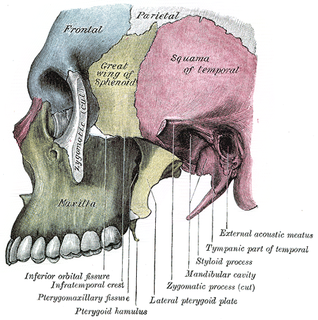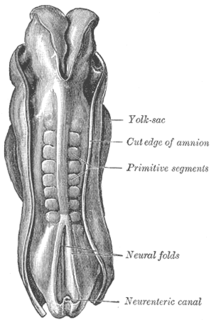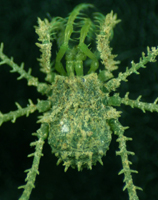Stomotheca is the term applied to the feeding apparatus in front of the mouth of harvestmen, and sometimes the related scorpions. Usually it consists of the epistome (labrum), two pairs of coxapophyses (endites, maxillary lobes) and often a labium . [1]

Scorpions are predatory arachnids of the order Scorpiones. They have eight legs and are easily recognized by the pair of grasping pedipalps and the narrow, segmented tail, often carried in a characteristic forward curve over the back, ending with a venomous stinger. Scorpions range in size from 9 mm / 0.3 in. to 23 cm / 9 in..

The labrum is a flap-like structure that lies immediately in front of the mouth in almost all extant Euarthropoda. The most conspicuous exceptions are the Pycnogonida, which probably are chelicerate-relatives. In entomology, the labrum amounts to the "upper lip" of an insect mouth, the corresponding "lower lip" being the labium.

The maxilla in animals is the upper fixed bone of the jaw formed from the fusion of two maxillary bones. The upper jaw includes the hard palate in the front of the mouth. The two maxillary bones are fused at the intermaxillary suture, forming the anterior nasal spine. This is similar to the mandible, which is also a fusion of two mandibular bones at the mandibular symphysis. The mandible is the movable part of the jaw.
The epistome is a projection that forms the anterior wall of the stomotheca. Its upper side is hardened and divided by a transverse invagination (sulcus). The part nearer the groove is sometimes called clypeus, the other one labrum. The area around the mouth is soft and flexible, often with a distal lobe. On the sides, the walls around the mouth are fused to the medial surfaces of the pedipalpal coxae, and a transverse muscle attaches to the inner surfaces of the epistomal walls. [1]

The clypeus is one of the sclerites that make up the "face" of an arthropod. In insects, the clypeus delimits the lower margin of the face, with the labrum articulated along the ventral margin of the clypeus. The mandibles bracket the labrum, but do not touch the clypeus. The dorsal margin of the clypeus is below the antennal sockets. The clypeus is often well-defined by sulci ("grooves") along its lateral and dorsal margins, and is most commonly rectangular or trapezoidal in overall shape.
Coxapophyses are extensions from the pedipalps and first pair of legs. While hardened at the base, they end in large soft pads that work as lips. It some species there is a narrow canal (pseudotrachea) on the posterior surface of the pedipalpal coxapophysis, possibly conducting fluids into the digestive tract. Salivary glands lead into the preoral chamber from both pairs of coxapophyses. While most harvestmen have coxapophyses on the second pair of legs as well, these do not end in pad-like structures and are reduced in many groups. Where they are fully developed, they probably aid in food intake. Similar lobular structures are sometimes found on the two latter pairs of legs as well, but their function is unknown. [1]

The salivary glands in mammals are exocrine glands that produce saliva through a system of ducts. Humans have three paired major salivary glands as well as hundreds of minor salivary glands. Salivary glands can be classified as serous, mucous or seromucous (mixed).
The labium, when present, is a flattened plate derived from the somite of the first walking leg. While large in many Eupnoi and Dyspnoi, it is small in most Laniatores and absent in Cyphophthalmi. [1]

Somites are divisions of the body of an animal or embryo. The divisions are also known as metameric segments

The Eupnoi are a suborder of harvestmen, with more than 200 genera, and about 1,700 described species.

Dyspnoi is a suborder of harvestmen, comprising 40 genera, and over 340 described species. The eight families are currently grouped into three superfamilies: the Acropsopilionoidea, Ischyropsalidioidea, and Troguloidea.
The term stomotheca is derived from Ancient Greek stoma "mouth" and theca "case, box".

The Ancient Greek language includes the forms of Greek used in Ancient Greece and the ancient world from around the 9th century BCE to the 6th century CE. It is often roughly divided into the Archaic period, Classical period, and Hellenistic period. It is antedated in the second millennium BCE by Mycenaean Greek and succeeded by medieval Greek.










